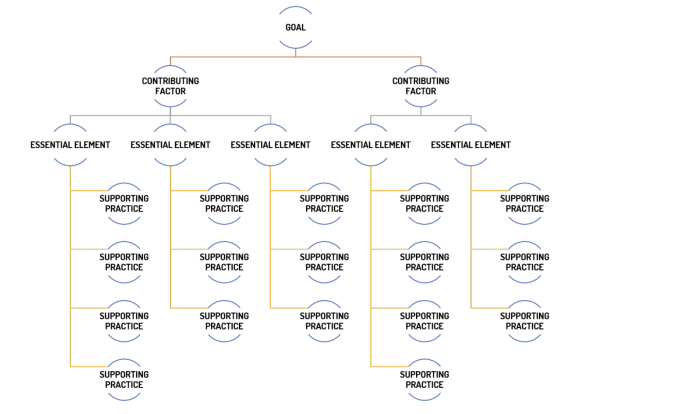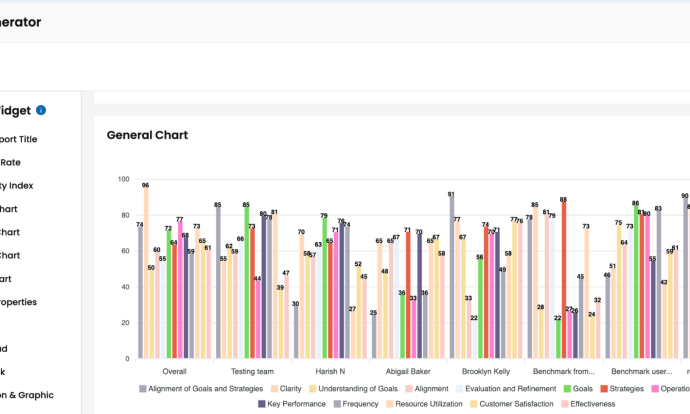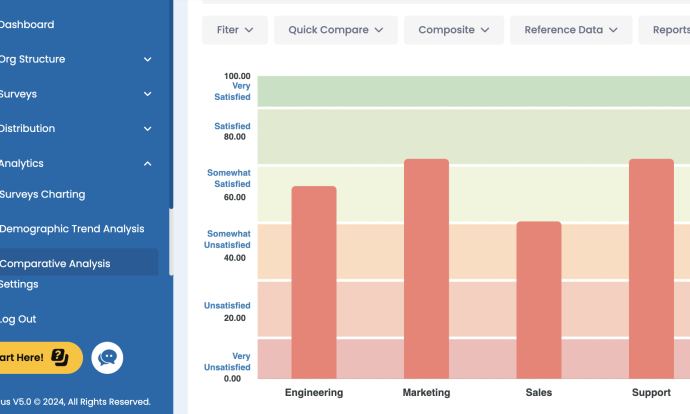How to Improve Employee Engagement Surveys & Drive Results

Recent studies indicate a growing trend of employees actively seeking new job opportunities despite reporting high engagement or satisfaction levels. For instance, a survey conducted in November 2024 revealed that more than half of 20,000 U.S. workers were either watching for or actively seeking new jobs, marking the highest percentage since 2015.
This surge in job hunting occurs even as some employee engagement survey metrics remain positive, suggesting that traditional engagement surveys may not fully capture underlying employee dissatisfaction. (Source: WSJ)
That’s why we at Metolius advocate for a new method of intelligent questionnaires. Unlike conventional surveys which focus on structured raw data collection, Metolius uses a structured, analytic approach to deliver actionable insights by aligning every question with specific organizational goals.
In this blog we will explore how leaders like you can leverage this methodology to measure employee engagement better to keep top talent and build thriving workplace cultures.
Why Employee Engagement Surveys Fail
1. Data Overload Without A Clear Purpose
Many surveys attempt to cover an extensive range of topics, leading to an overwhelming amount of data. This can result in “analysis paralysis,” where HR leaders struggle to derive actionable insights. According to Gartner, 75% of HR leaders believe managers are overwhelmed by their responsibilities, and 70% report that current leadership programs do not prepare managers for future demands.
2. Misaligned or Ineffective Questions
Traditional employee engagement surveys often rely on generic, standalone questions that fail to connect back to the organization’s broader goals. Questions like “Do you feel engaged at work?” may generate high scores, yet companies still struggle with retention—suggesting these surveys aren’t measuring the right things or aren’t structured to drive action.
McKinsey research highlights that many organizations fail to align their engagement strategies with meaningful business outcomes, resulting in insights that don’t translate into impact. Instead of focusing on engagement as a vague concept, surveys should be designed to measure the specific drivers of engagement—such as career growth, leadership trust, or psychological safety—each of which directly influences retention and performance.
When questions are thoughtfully structured around clear, measurable themes, HR leaders gain insights that not only diagnose engagement issues but also point to actionable solutions—whether that’s strengthening leadership communication, improving recognition programs, or expanding career development opportunities. By ensuring that each survey question ladders up to a defined outcome, organizations can move beyond collecting data and start making meaningful improvements to workplace culture.

3. Delayed Action on Survey Results
There’s often a long gap between collecting survey data and taking action. By the time plans are made after a suvey is done, life moves on—priorities shift, teams change, new challenges come up, and external factors reshape the workplace. The data is outdated, and employees’ feelings may have already shifted. Gartner points out that 74% of HR leaders believe managers struggle to effectively drive change, making it even harder to respond to survey results in a meaningful and timely way.
What Sets Intelligent Employee Engagement Surveys Apart?
Standard surveys typically focus on raw data collection—counting responses and identifying trends. While useful, they often leave HR teams struggling to translate results into strategies. Intelligent surveys, however, take a different approach: they align every question with an assessment goal and embed analytics that immediately generate actionable insights.
Imagine trying to assess employee morale after a leadership change. A standard survey might ask, “How satisfied are you with the leadership team?” In contrast, an intelligent survey would identify the specific factors that influence morale—communication, transparency, and trust—and craft targeted questions to measure each. These questions should capture various themes such as leadership perception, career opportunities, and job satisfaction, often using a Likert scale to gather quantifiable data from employee experiences. The result? Clearer insights and stronger alignment with your organization’s goals.
How to Build Intelligent Employee Engagement Surveys
1. Define Your Objective
Start with the end in mind. What do you want to achieve with your survey? When designing your employee engagement survey, it’s helpful to outline initial hypotheses or assumptions about potential findings. This can guide the survey’s focus while ensuring it captures the right data.
However, take care to avoid introducing bias—craft questions objectively and allow data to validate or challenge your assumptions. Including this consideration in the survey objective step ensures the design process remains strategic and balanced.
By clearly defining your objective, you set a clear direction for the survey, ensuring each question contributes to actionable outcomes. Objectives focus on the broader “why” of the survey.
For example, are you aiming to:
- Improve employee retention?
- Identify leadership gaps?
- Strengthen workplace culture?
2. Align Questions With Key Themes
Once the objective is set, break it down into specific themes that directly support it. Key themes are the “how” and “what” you assess to achieve your objective.
For instance:
- If the objective is to improve retention, themes could include career development, work-life balance, and managerial support.
- If the goal is to understand leadership gaps, focus on communication effectiveness, trust, and decision-making alignment.
Structuring your survey around these themes ensures questions are focused and actionable, avoiding the trap of collecting irrelevant data.

3. Structure Questions Thoughtfully
- Use Likert scales (e.g., strongly disagree to strongly agree) to measure intensity, not just yes/no responses.
- Include a “don’t know” option when appropriate, but recognize that in some contexts, such as compliance, uncertainty may indicate a gap that needs addressing.
- Avoid “double-barreled” questions that ask about two factors at once, like, “Do you feel your manager is supportive and knowledgeable?” Break these into separate questions for clarity.
When structuring survey questions, thoughtfully consider how they assess employee sentiment and morale.
4. Focus on Data Quality
The insights you gather are only as good as the data you collect. Conduct a pretest to ensure that respondents interpret questions as intended and that the survey’s flow feels intuitive.
Ensure data quality by conducting a pretest to verify that respondents understand the questions as intended. Here are five key questions to validate:
- Do the questions align with the survey’s overall objective?
- Are the questions free of ambiguity or complex language?
- Does the sequence of questions feel logical and intuitive?
- Are the response options comprehensive and unbiased?
- Does the survey flow maintain respondent engagement throughout?
Metolius can help you create these intelligent surveys and analyze responses, providing real-time insights. Want to know more?

High Impact Questions to Ask in Employee Engagement Surveys
Appreciation/Recognition
- I feel appreciated as an individual in my organization. (Scale: Strongly Disagree to Strongly Agree)
- I receive recognition for my achievements at work. (Scale: Strongly Disagree to Strongly Agree)
Leadership & Communication
- Leadership communicates important information transparently. (Scale: Strongly Disagree to Strongly Agree)
- Leadership has communicated a vision that motivates me. (Scale: Strongly Disagree to Strongly Agree)
Collaboration
- There is a strong sense of community within my team. (Scale: Strongly Disagree to Strongly Agree)
- I feel connected to the organization’s mission and values. (Scale: Strongly Disagree to Strongly Agree)
Professional Development
- There are professional development opportunities available to me. (Scale: Strongly Disagree to Strongly Agree)
- I feel my work contributes to the success of this company. (Scale: Strongly Disagree to Strongly Agree)
Job Satisfaction and Work-Life Balance
- I am satisfied with my current job role. (Scale: Strongly Disagree to Strongly Agree)
- I feel supported in maintaining a healthy work-life balance. (Scale: Strongly Disagree to Strongly Agree)
Open-Ended Insights
- What would make the biggest difference in improving your experience at work?” (Focuses responses on the most impactful change rather than a wishlist.)
- What do you want leadership to know or change to make this a better place to work? (Directly invites employees to voice concerns or needs in a way leadership can act on.)
Going from Data to Action
Effective employee engagement surveys shine in their ability to deliver actionable insights. Here’s how to make the most of your data:
- Segment Responses: Analyze results by department, role, age, tenure and other demographics to uncover patterns.
E.g. Newer employees might express challenges with onboarding processes, such as unclear expectations or limited access to resources. In contrast, tenured employees may highlight the need for structured career growth plans or advanced training opportunities to stay engaged. - Prioritize Findings: Focus on areas that will have the greatest impact on your assessment goal.
E.g. If your survey reveals that employees with high potential are dissatisfied with leadership communication, prioritize improving communication channels or developing training programs for managers on transparency and active listening, as this directly affects retention. - Use Visual Dashboards: Present insights in a way that’s easy for stakeholders to understand and act upon.
E.g. Create dashboards that highlight trends like declining satisfaction scores in a specific team, linking it to leadership gaps or workload issues. Include visual indicators like heatmaps or trendlines to make the data intuitive.

- Collaborate Across Teams: Don’t keep survey results siloed—share them with leadership and department heads so you can work on the challenges together.
E.g. If the survey shows a decline in teamwork, don’t just assume a team-building activity will fix it. Get department heads involved to dig into the root cause—maybe it’s a lack of cross-team communication, unclear roles, or remote work challenges. From there, co-create solutions like better collaboration tools, structured team check-ins, or targeted workshops that actually address the problem. - Use Surveys as a Jumping-Off Point for Action: A survey isn’t just a report—it’s the start of a conversation. Instead of treating results as a one-and-done exercise, zero in on the lowest-scoring areas and use them to spark meaningful change. When structured well, a survey helps pinpoint where employees are struggling and provides a clear direction for next steps—without needing endless follow-up discussions.
E.g. If work-life balance scores low, the takeaway isn’t just “employees want more time off.” The data might reveal deeper issues like meeting overload, workload distribution, or unclear expectations. With the right framework, surveys can surface these insights upfront, allowing leadership to take action quickly—whether that’s adjusting workload policies, refining PTO structures, or improving communication around expectations.
In Conclusion
Employee engagement surveys aren’t just about gathering opinions—they’re a powerful tool for driving real change. When designed thoughtfully, they help you spot trends, address gaps, and create a workplace where employees feel valued and motivated.
We hope this guide gives you a clear roadmap to building surveys that lead to action, not just data. At Metolius, we’re passionate about helping organizations turn insights into impact. We’d love to hear your thoughts—drop a comment below or reach out at [Email Address].


